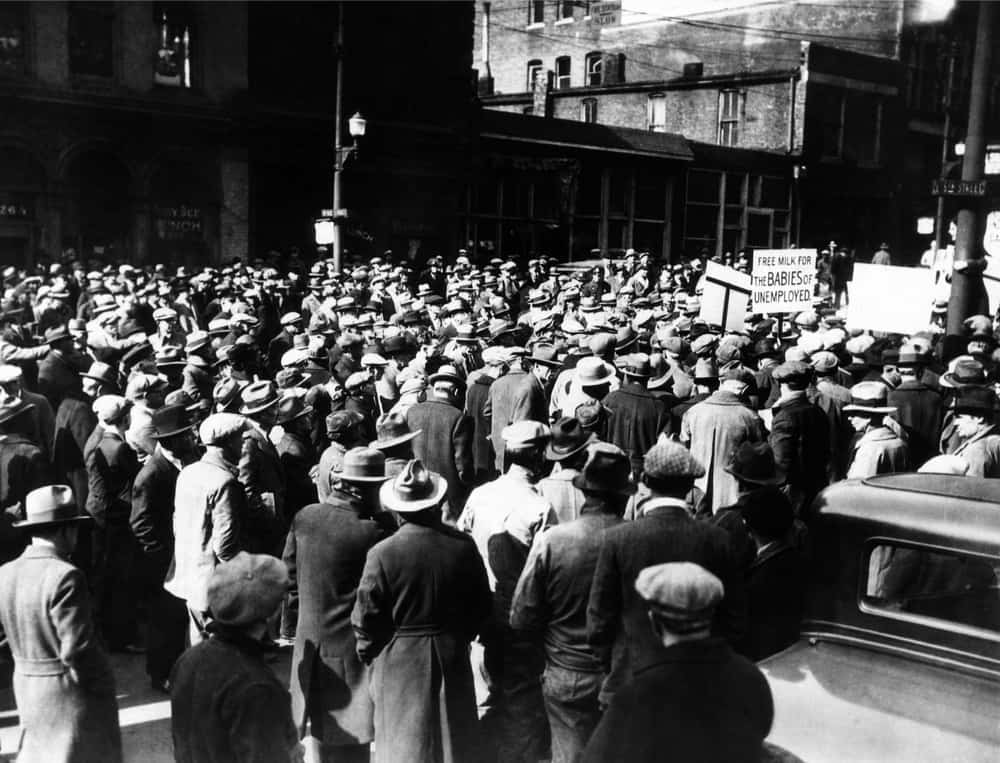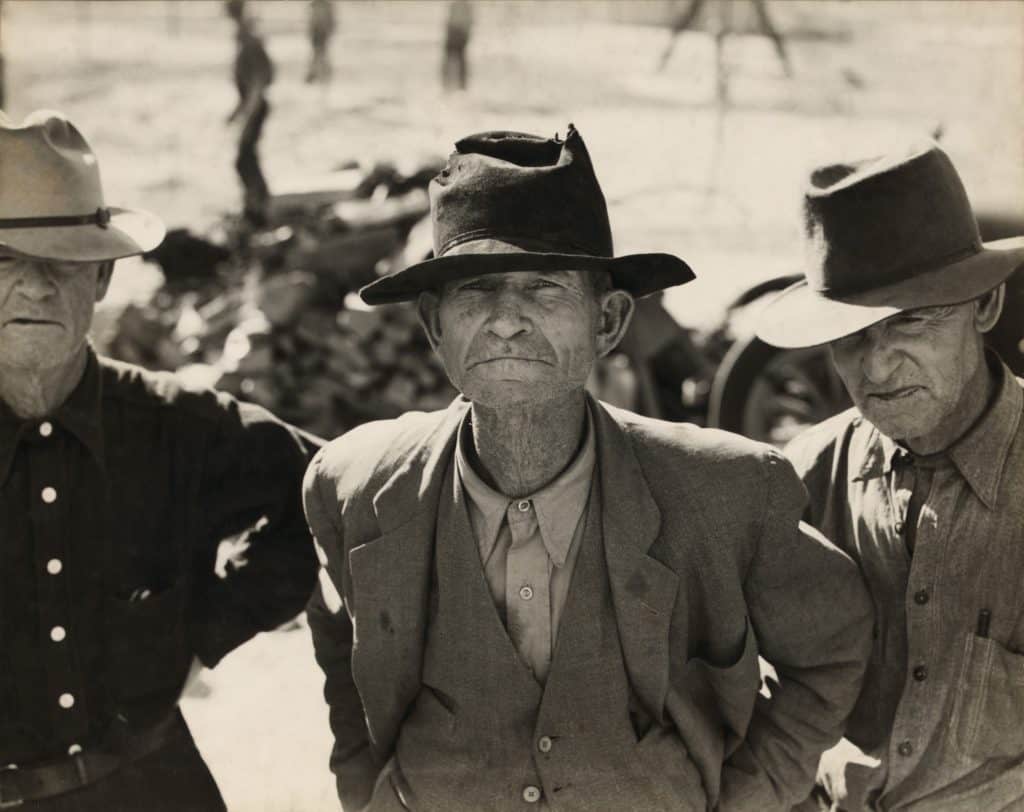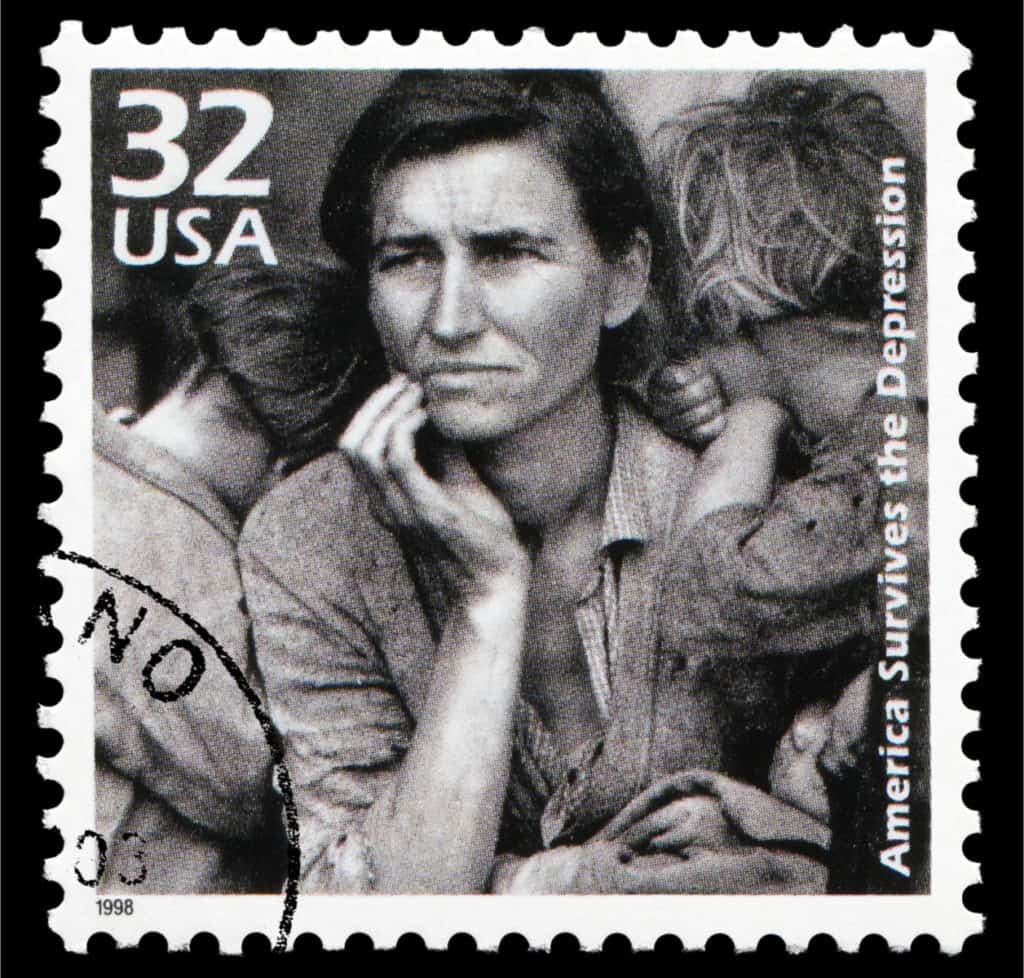Government policies mandating elevated wage rates during the Great Depression priced millions of poor people out of work for the duration of the 1930s. Now the Biden administration, having learned nothing, is determined to repeat FDR’s disaster, even down to the “New Deal” name and its “100 Days.”

by Richard Schulman
Biden’s New Deal and his Hundred Days of green executive orders promise to be as much of a failure as their FDR original was during the Depression. We’ll show that, first, by providing a capsule history of FDR’s New Deal; second, by showing how a central feature of the Biden-Democratic Party program – a hike in the minimum wage to $15 an hour – replicates the most important blunder of the original New Deal.
That blunder – government policies mandating elevated wage rates during the Great Depression – priced millions of poor people out of work, condemning them to hunger, homelessness, and other miseries for the duration of the 1930s. By obsessively persisting in that blunder, the US and France were the only advanced economies that failed to recover during the decade.
It was World War II spending, not the New Deal, that finally pulled the US out of the Hoover-FDR Great Depression.
Progressive myth-making
The version of FDR’s New Deal that has been circulated by progressive historians and economists — and become accepted opinion – is a myth. Progressives claim that criticism of their myth is confined to malicious right-wing ideologues. But the two works that we will extensively quote from are by authors with libertarian leanings who “don’t have a dog in the fight” between Republicans and Democrats. The works are Richard Vedder and Lowell Gallaway’s Out of Work: Unemployment and Government in Twentieth-Century America (abbreviated “OoW”), published by The Independent Institute, and George Selgin’s work-in-progress [scroll to end for index and links] The New Deal and Recovery,” published by Cato and Alt-M.
Selgin writes:
One doesn’t have to be a Herbert Hoover fan to conclude that New Deal programs, taken as a whole, failed to achieve a lasting recovery from the Great Depression. Indeed, for most of the postwar period… conventional wisdom had it that the New Deal didn’t end the Great Depression. Instead, WWII was supposed to have done so. Nor was this a “right wing” perspective. It was shared by many to the left of center, including several former New Dealers themselves.
The delusion that wages are not governed by market forces
The OoW authors write:
Somewhere about one-third of the way through the twentieth century, the world abandoned an approach to business fluctuations and unemployment that had previously governed human behavior. In the world of economic ideas, the halfheartedly-believed theory that excessive wages were the root cause of unemployment was overthrown…. While the world has increasingly appreciated the power of markets in allocating goods and services, it has failed to grasp that the same market forces work equally well in providing jobs for those seeking them.
The importance of adjusted real wages
What does economic theory have to say about why FDR’s New Deal prolonged the Great Depression rather than ending it? OoW explains:
Unemployment is created when existing wage rates exceed the level necessary to ‘clear’ the labor market. Just as a surplus of wheat exists if the prevailing price is above the equilibrium level that equates the quantity supplied and the quantity demanded, so there is a surplus of labor – unemployment – when the prevailing price, or wage, of labor exceeds the equilibrium level that eliminates unemployment.
More precisely, the adjusted real wage determines whether the labor market will clear, with jobs available for all who wish to work. The adjusted real wage is arrived at by a two-step procedure. The real wage consists of the money wage divided by the price level. This is the wage that workers pay attention to. The adjusted real wage is the real wage per unit of physical output, i.e., a worker’s productivity. This is the wage the employer must attend to. Higher adjusted real wages mean higher unemployment.
Both OoW and Selgin’s Cato series show how New Deal policies raised adjusted real wages – generously benefiting those already employed but condemning to decade-long poverty the millions of unemployed and teenagers unable to find work. That is the dirty little secret of FDRs original New Deal and Biden’s ersatz namesake — tragedy repeating as farce.
Mussolini and Hitler, not FDR
Did New Deal policies engineer the mini-recovery of 1933-1937? Not at all, Selgin writes. “The U.S. economy owed most of the recovery it experienced between 1933 and 1937 to an onrush of ‘hot money’ from Europe that revived aggregate spending… not to any steps FDR took in the U.S., but to the martial maneuverings of Benito Mussolini and Adolph Hitler.”
He continues:
But the biggest disappointment was the persistence of high unemployment…. The unemployment rate as conventionally measured (with workers in government relief programs counted as unemployed) stayed obstinately above 15 percent until 1936 and was still above 10 percent in the late summer of 1937. It then rose sharply again as the new depression took hold. To put these numbers in perspective, between April and September 1929, the highest recorded unemployment rate was just above 2 percent.
The partial recovery of the 1933-1937 period maps well to the adjusted real wage model of OoW because it was during that period total factor productivity significantly increased. But what doomed that partial recovery was the significant rise in adjusted real wages by mid 1937. “In two years they’d risen 35 percent, and they would go on rising until the middle of the ‘Roosevelt Depression,’” Selgin writes.
New labor laws begin raising adjusted real wages
“The answer isn’t to be found among the laws of supply and demand,” Selgin continues:
But it can be found easily enough among the laws passed by the Roosevelt administration…. Starting in 1933 the Roosevelt administration adopted ‘New Deal’ labor policies embodied in the National Industrial Recovery Act (NIRA), which established the National Recovery Administration (NRA) codes, and the 1935 National Labor Relations Act (NLRA or Wagner Act). NRA codes boosted nominal wage rates and imposed ‘labor standards’ such as overtime premium pay, by regulatory fiat. Both the NIRA and the NLRA promoted formation of labor unions and strengthened workers’ bargaining power over employers…. Establishing minimum wage rates had in fact been the original aim of what became the NIRA. Like many people, FDR believed that higher wage rates would translate into an overall increase in workers’ ‘purchasing power,’ which, by enabling them to spend more, would in turn promote recovery.… The result disappointed practically everyone…. William Randolph Hearst had a point when he quipped that NRA really stood for ‘No Recovery Allowed.’
Hoover and FDR: two progressives in agreement
The NRA’s failure was energized by bad economic theory. Selgin explains:
The belief that compelling firms to increase their workers’ wage rates would promote recovery, or the ‘high-wage doctrine,’ had its roots in the ‘underconsumption’ theory of depression, which reached its peak of popularity during the 1920s. According to that theory, depressions happened when workers collectively weren’t paid enough to buy the output their employers produced…. Hoover and Roosevelt may have disagreed about many things, but both of them subscribed to it. The difference between them was that, while Hoover merely tried to persuade businessmen to resist cutting their workers’ wage rates, FDR compelled firms to abide by the NRA’s codes: besides risking criminal prosecution and fines of up to $500 per violation, firms that failed to follow the codes could have their business licenses revoked—the business equivalent of the death penalty.
One of the most severe critics of the NIRA and NRA was the FDR-sympathetic Brookings Institution, which wrote a 100-page study of the NRA’s failings in 1935. Selgin summarizes:
’It did not seem to occur to the NRA,’ the report caustically observes, ‘that a high price for labor might restrict the amount used.’ Because NRA wage codes applied only to about half of all workers, and mainly to those employed at relatively high-paying mining and manufacturing firms, and because these gains often overcompensated for concurrent changes in the cost of living, the NRA chiefly rewarded workers who ‘were already making more income per hour than they made before the depression,’ and did so almost entirely at other workers’ expense.
Farmers, farmworkers, and their families, who made up more than a quarter of the population, were among those made worse off by the NRA codes. That outcome was bitterly ironic, because one of the New Deal’s chief concerns was the plight of farmers…
The Wagner Act, the NLRA, and the NLRB
The Supreme Court helped the cause of farmers and the unemployed by declaring the NIRA unconstitutional in May 1935. But the FDR administration responded by passing the Wagner or National Labor Relations Act two months later. The share of unionized workers and the number of strikes now doubled between 1935 and 1939. The National Labor Relations Board (NLRB), the Wagner Act’s enforcement agency, strengthened workers’ right to form unions and to strike. It also forced employers to rehire workers who had been fired for taking part in sit-down strikes. The net effect of these government policies was to produce a major increase in the adjusted real wages of those employed – at the expense, once again, of the millions of unemployed.
Selgin:
[T]he importance of the NRA’s failure shouldn’t be underestimated….[I]t was, as its name suggests, the centerpiece of FDR’s recovery plan—the principal device by which the U.S. economy was to be helped back on its feet. The NRA’s failure therefore meant, not just that FDR would have to rely on other parts of the first New Deal to achieve recovery, but that he and his advisers would have to go back to the drawing board to concoct new recovery plans. Alas, those new plans were no more successful than the NRA.

Another failure: the Agricultural Adjustment Act
One of the most important of these failures was the Agricultural Adjustment Act (AAA). Threatened with falling prices and foreclosures on farm mortgages after WWI, farmers wanted price supports. Hoover opposed such efforts because he “believed that propping-up farm product prices would only result in still larger farm surpluses and that the [proposed] export corporation’s efforts to dispose of surplus crops abroad would violate the era’s anti-dumping laws,” Selgin writes. “It fell to FDR to grant farmers the sort of immediate and substantial aid they’d been pining for for a decade.” The key idea behind the AAA was that direct payments would be made to farmers “in return for their agreeing to limit output to allotted amounts, to be financed by taxes on food processors.”
Although the AAA raised farm earnings, there was a major drawback. Selgin reports that the payments
mostly ended up going to landlords, rather than to their tenants or to actual farm workers. When AAA benefits went to cash-paying tenants, they tended to be fully offset by higher rents. When, instead, they were meant to be divided between sharecroppers and their landlords, as in the cotton-growing South, the landlords often prevented sharecroppers from being paid directly, while dispensing with those they no longer needed. As a result, hundreds of thousands of tenant farmers and their family members found themselves homeless, with no means of survival save those offered by other New Deal relief programs. A Cornell agricultural economist estimated that, all told, the AAA added roughly 2 million former farm tenants and workers to the ranks of the unemployed.
The AAA was sold to the public as an emergency measure, was struck down by the Supreme Court as unconstitutional for using taxes on food processors to benefit farmers, but in successor forms has continued as a pernicious protectionist measure for agriculture down to the present day, benefiting a minority of large farmers at the expense of consumers and taxpayers.
The 1937-1938 “Roosevelt Depression”
The Supreme Court’s rulings against both the NIRA and AAA, though vociferously denounced by the Roosevelt administration, removed a brake on the economy and helped increase employment at first. But all this was deep-sixed by the “Roosevelt Depression” that began in his second term.
Intimidated by FDR’s threat to pack it during his 1936 re-election campaign, the Supreme Court became more friendly to new FDR employment-damaging measures – the notorious “switch in time that saved nine.” Selgin describes the effect:
In May, according to the NBER’s business cycle chronology, the economy started shrinking again. Expenditures fell; inventories accumulated; and profits dwindled. Soon it was obvious to all that the U.S. was in the throes of yet another severe recession. By the time it was over, in June 1938, real U.S. GNP had fallen by 18.2 percent. That was less than the 26.6 percent decline suffered in the early years of the depression. But as is clear from the chart below, it happened much more quickly, and was in that respect even more stunning. The setback was also severe enough to undo a substantial part of the gains achieved since FDR took office…. Between May 1937 and June 1938, industrial production fell by almost one third—a truly stupendous drop.
Adjusted real wages forced up by unionization and supplementary payments
Vedder and Galloway’s OoW observes:
In 1936, the fringe benefit portion of total compensation began to explode…. The source of the rise in supplements was primarily employers’ contributions for social insurance, required under the Social Security Act of 1935. In 1935, before that legislation was operative, they accounted for 25 percent of all supplements, while in 1938, they were some 71 percent of supplements…. [I]n 1938 the newly emerging national retirement system had raised wage costs by about 0.85 percent, while the unemployment system added another 2.2 percent…. [T]he impact on unemployment of these various changes in wage costs can be estimated…. They suggest that unionization was the more important cause of prolonged high unemployment, but that employer social security contributions raised the unemployment rate about another 2.2 percent. Put differently, nearly 1.2 million people were added to the unemployment rolls by 1938 because of the increases in labor cost associated with social insurance programs.
In short, “the Great Depression was very significantly prolonged in both its duration and its magnitude by the impact of New Deal programs.”
OoW concludes
[I]n a very real sense Roosevelt merely continued and expanded upon the high-wage doctrine first articulated by Hoover. Far from being the bold new reformer saving the nation from the laissez-faire prescriptions of a reactionary president, Roosevelt was a chief executive who adroitly and charismatically expanded the legacy left by his progressive, if colorless, predecessor.

Et tu, Mr. Biden?
As Jason Riley explains in his Wall Street Journal column titled “The Minimum Wage’s Racially Discriminatory Roots,”
Poor families need jobs more than they need raises. And what teens and young adults most need are opportunities to accumulate job experience that can lead to higher pay and upward social mobility down the road. By reducing employment opportunities, minimum-wage laws can make inequality worse. Low-income minorities stand to lose the most from lifting the wage floor because they are over-represented among less-skilled and less-experienced workers. Labor economists William Even and David Macpherson’s study of the impact of state minimum-wage mandates in 2007-09 found that they cost younger blacks more jobs than the Great Recession did.
…
This is exactly what the early 20th century minimum-wage proponents were hoping these laws would do: keep black workers from competing for jobs. [emphasis added]
The Biden-Democratic Party plan to hike the minimum wage to $15/hr. and emulate, mutatis mutandis, FDR’s New Deal, can be expected to have similar disastrous effects as its original. It will raise adjusted real wages to benefit some of the employed by creating millions of permanently unemployed. The Biden administration will then try to paper over this failure, just as the FDR administration did earlier, by accompanying its New New Deal with its habitual companion, a New New Dole.

GOOD READ OF HISTORY
“The version of FDR’s New Deal that has been circulated by progressive historians and economists — and become accepted opinion – is a myth. Progressives claim that criticism of their myth is confined to malicious right-wing ideologues. But the two works that we will extensively quote from are by authors with libertarian leanings who “don’t have a dog in the fight” between Republicans and Democrats.”
That’s hilarious. They may not have a dog in the fight between Republicans and Democrats, but they most assuredly have a dog in the fight on this and every other issue involving economic policy, and “libertarian leanings” means they are very much on the right on such issues. Pull the other one.